
N.C. OCME Annual Report 1993
Back to Annual Report Index | Chapter 7
Chapter 6: Motor Vehicle Accidents
Of the 2,611 deaths that were ruled accidental in manner, 1,513, or 58 percent, involved motor vehicles. Figure 18 shows that drivers involved in a collision with another motor vehicle comprised 31.8 percent of the deaths, followed by drivers not involved in a collision with another vehicle (22.4%) and passengers involved in a collision with another motor vehicle (12.6%). Of the 1,151 drivers and passengers killed in single-or multiple-vehicle crashes, 365 or 31.7 percent, were known to be using a seat belt or other restraint.
Figure 18
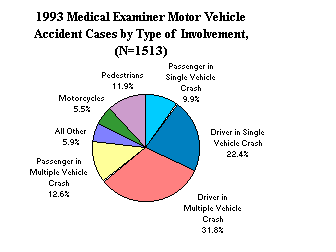
The percentages of alcohol use for each type of motor vehicle accident deaths are shown in Figure 19. Alcohol was a major factor among drivers in a single-vehicle accident, passengers in a single-vehicle accident, pedestrians, and motorcycle users.
[Figure 19 is unavailable.]
Table 9 reveals that in 1992 and 1993, the percentage of drivers in single-and multiple-vehicle crashes who had been drinking declined. Pedestrian alcohol use has also declined since 1992.
The percentages of intoxicated decedents (defined as having a blood alcohol level of 100mg/dl or more) by circumstance and time of injury are shown in Figure 20. The time period 9 p.m. - 3 a.m. had the highest percentage of intoxicated decedents except for multiple vehicle crashes, in which a larger number occurred between 3 p.m. – 9 p.m. Half of fatally injured pedestrians and over one third of drivers in single vehicle fatalities occurring between 9 p.m. and 3 a.m. had blood alcohol levels at or above DWI levels.
Figure 20
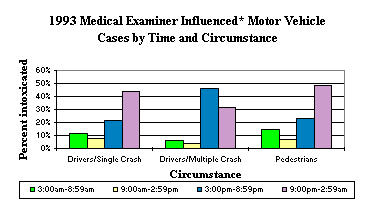
*Tested alcohol level >=100mg/dl
Table 10 shows motor vehicle accident death rates by race and sex. Nonwhite males had the highest death rate and the death rates for males was more than double that of females. Alcohol involvement was most common in motor vehicle accident deaths involving white and nonwhite males (Figure 21).
Table 9: 1988-1992 Medical Examiner Motor Vehicle Driver and Pedestrian Fatalities By Year, Circumstance, and Alcohol Level
| Circumstance | 1989 | 1990 | 1991 | 1992 | 1993 | Total |
|---|---|---|---|---|---|---|
| Drivers in Single Vehicle Crashes | ||||||
| Sober | 118 (38%) | 122 (36%) | 126 (42%) | 132 (44%) | 160 (51%) | 632 (39%) |
| Drinking | 18 (6%) | 26 (8%) | 15 (5%) | 22 (7%) | 20 (6%) | 104 (6%) |
| Influenced | 172 (56%) | 192 (56%) | 160 (53%) | 145 (49%) | 136 (43%) | 871 (54%) |
| Number Tested | 308 (88%) | 340 (89%) | 301 (88%) | 299 (89%) | 316 (94%) | 1607 (89%) |
| Deaths | 352 | 381 | 343 | 336 | 337 | 1806 |
| Drivers in Multiple Vehicle Crashes | ||||||
| Sober | 342 (80%) | 291 (80%) | 264 (81%) | 276 (84%) | 364 (85%) | 1503 (80%) |
| Drinking | 17 (4%) | 15 (4%) | 9 (3%) | 14 (4%) | 19 (4%) | 81 (4%) |
| Influenced | 69 (16%) | 60 (16%) | 53 (16%) | 40 (12%) | 48 (11%) | 304 (16%) |
| Number Tested | 428 (87%) | 366 (85%) | 326 (86%) | 330 (86%) | 431 (90%) | 1888 (87%) |
| Deaths | 493 | 432 | 379 | 383 | 479 | 2174 |
| Pedestrians | ||||||
| Sober | 90 (49%) | 85 (48%) | 79 (45%) | 65 (38%) | 91 (52%) | 428 (48%) |
| Drinking | 5 (3%) | 10 (6%) | 5 (3%) | 10 (6%) | 10 (6%) | 35 (4%) |
| Influenced | 87 (48%) | 82 (46%) | 90 (52%) | 96 (56%) | 74 (43%) | 436 (48%) |
| Number Tested | 182 (86%) | 177 (89%) | 174 (87%) | 171 (92%) | 174 (97%) | 899 (88%) |
| Deaths | 212 | 199 | 199 | 185 | 180 | 1022 |
| Sober = < 20 mg/dl Drinking = 21-99 mg/dl Influenced > 100 mg/dl | ||||||
Table 10: 1993 Medical Examiner Motor Vehicle Accident Death Rates by Race and Sex (per 100,000 population)
| White | Nonwhite | Total | |
|---|---|---|---|
| Male | 28.3 | 39.2 | 30.8 |
| Female | 12.9 | 14.2 | 13.2 |
| Total | 20.4 | 25.9 | 21.7 |
Figure 21
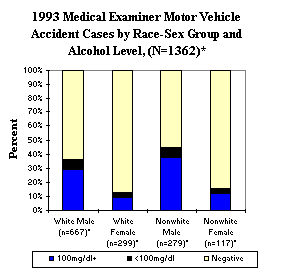
*Total tested for alcohol
Motor vehicle accident death rates by age and the age-specific percentage of motor vehicle accident deaths by alcohol level are shown in Figures 22 and 23 respectively. The age group 15-24 had the highest death rate, while the age group 25-34 had the highest percentage of victims intoxicated. Alcohol was involved in at least a third of cases in all but the 65+ age group.
Figure 22
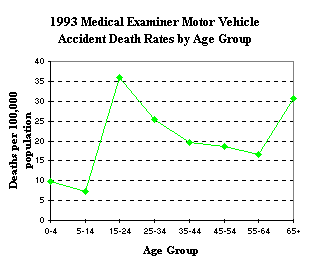
Figure 23
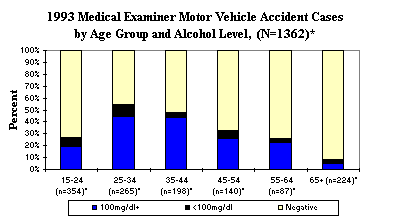
*Total tested for alcohol
Figure 24 shows that the highest number of deaths overall occurred primarily between 3 p.m. and 11 p.m. Non-drinking victims were killed during daylight hours; while drinkers died between late afternoon and early morning hours. Figure 25 shows that fatal accidents were most common on weekends.
Figure 24
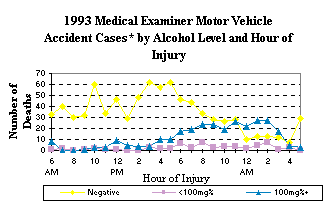
*Total tested for alcohol
Figure 25
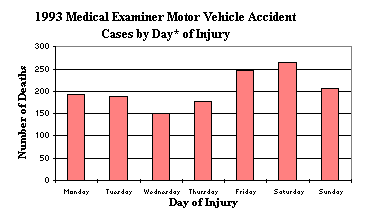
*Day runs from 6:00am -5:59 am